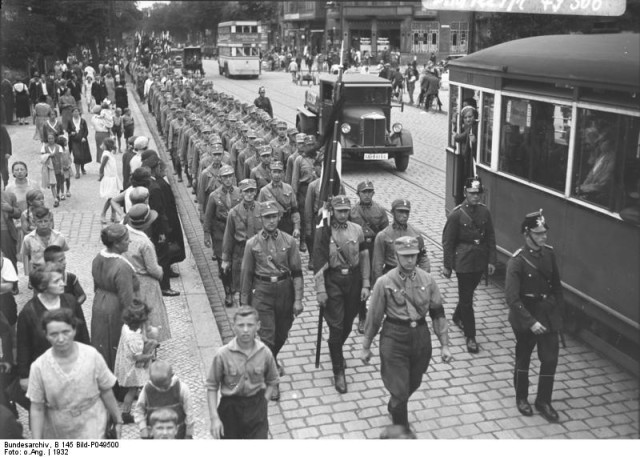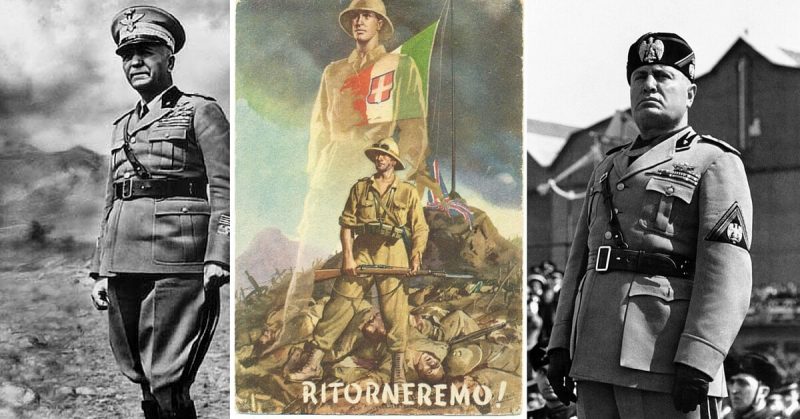It is almost completely unknown, but in the wake of the Second Italo-Abyssinian war, Mussolini was quite keen on making his own equivalent of the French Foreign Legion. He ordered a study to be conducted on August 3, 1935, regarding the possibilities of forming the Legion with the analysis of all necessary aspects.
It was concluded that with proper advertisement and financial support, there should be a large interest all over the world in joining the Italian cause in East Africa. The idea almost came into effect, but the concept made in the hope of creating an ideologically backed international strike force didn’t turn out as it was expected.
The Commander of the Army General Staff, Marshal Badoglio, was very careful in showing his animosity towards employment of foreign troops in a war that represented national pride and a revenge effort against the Ethiopians who, during the First Italo-Abyssinian conflict in 1896, defeated the Italians against all odds. At first, he approved the idea, but soon after he started delivering arguments against it.
The image of the Italian army in the world was badly shaken after the defeat in Ethiopia in 1896. The war that started in 1935, apart from its colonial and imperial justifications, was also an attempt to regain lost honor. Therefore, Badoglio didn’t want to rely on foreign volunteers, for in case of victory, the European press would perceive at as the victory of the volunteers and not of the Italian army which was in dire need of proving itself under the new, fascist leadership.
After the study was successfully conducted, it was determined that the unit would include approximately 10,000 soldiers, among whom there would be 225 officers and 269 NCO’s (non-commissioned officers). The word was spread and applications arrived. Thousands of letters, papers and circulars were sent to the Italian Ministry of Foreign Affairs and most of them are preserved even today. But even throughout 1936, the number of men who successfully applied wasn’t more than 4,000. There were several thousand more men who applied on group applications, which weren’t acceptable, but even with those, the number still failed to reach the desired peak.
Mussolini hoped that he would receive support from fascist or nationalist paramilitary groups all over Europe who would send volunteers in help of the cause, but organizations such as the Austrian Hemwehr, the Belgian Legion National and French Croix de Feu, Francissme, the Jeunesses Patriotes and the Action Francaise believed that it was more necessary to build a movement in their own country, instead of participating in a foreign conflict.
The situation in Europe in the 1930s was unstable and the organizations now saw direct political gains in helping the Italian cause. An African conflict seemed so distant to the European fascists and nationalists who saw their chance to grow in the heart of their empires and not on the periphery.
Therefore, the turnout included mostly adventurers, unemployed war veterans from the First World War, mercenaries from South America or criminals on the run. Also, ironically, there was a group of Jews from Germany that were escaping Hitler’s racial laws, since Mussolini’s Italy hadn’t officially accepted the anti-Semite laws until 1938. Since many people were stripped of their citizenship by the Nuremberg Laws of 1935, they sought refuge in Italy.
Jews from Poland and Egypt offered to form a Hebrew Legion and in exchange expected Mussolini to grant them territories either in Ethiopia or in Palestine and enable the creation of the Jewish state. This peculiar fact shows how little anti-Semitism was associated with Mussolini in the year prior to the Second World War. These propositions were made by Alessandro Stain, the chief of the Jewish community in Abbazia, who served as a liaison on behalf of the Polish and German Jews interested in joining the Legion.

Among 345 German applicants, most were actually members of nationalist organizations in Germany that had lost their popularity rapidly when Nazis came to power in 1933. There were members of the paramilitary Freikorps, Stahlhelm party, which declared itself anti-nazi and even some SS and NSDAP members who distanced themselves from the Nazi Party. The Nazis conducted purges of their own, most notable one being the purge of SA (Sturmabteilung ) under Ernst Rohm who was executed in 1934 in the event known as the Night of the Long Knives.
Slight power shifts were happening within the party and many members felt jeopardized, so the International Fascist Legion sounded like a good place for a new start. There were also Russians who, in their hatred towards communism, started to lean towards fascism in 1930, veterans of the Chaco War between Paraguay and Bolivia. Here, too, were supporters of General O’Duffy from Ireland who openly supported the fascist regime of Franco and participated in the Spanish Civil War on his side, with a battalion 700 strong.
This is the list of all nationalities and the number of men that applied that was derived from letters of application saved by the Italian Ministry of Foreign Affairs:
Albania (40), Argentina (30), Armenia (2), Australia (4), Austria (250), Belgium (115), Bolivia (126), Brazil (13), Bulgaria (20), Canada (5), Chile (40), China (1), Costa Rica (7), Czechoslovakia (114), Denmark (15), Danzig (3), Egypt (102), England (122), Estonia (10), Finland (2), France (315), Germany (345), Greece (75), Hungary (189), India (25), Iraq (5), Ireland (3), Latvia (36), Liechtenstein (1), Lithuania (22), Mexico (4), Morocco (1), Netherlands (101), New Zealand (5), Norway (5), Palestine (8), Paraguay (4), Persia (1), Peru (6), Poland (105), Portugal (12), Romania (536), Russia (22), San Marino (14), South Africa (51), Spain (75), Sweden (23), Switzerland (20), Syria (13), Turkey (6), Uruguay (1), USA (45), Venezuela (25), Yemen (2), Yugoslavia (280). Not stated (30)
Total = 3432 men
Even though the Legion was never formed, we can conclude from available data that it wouldn’t have functioned as a politically motivated unit, but rather a Legion loyal to Italy, in the same way that the French Foreign Legion was to France. Even though this wasn’t Mussolini’s initial idea, it is reported that he was prepared to accept it, as a Foreign Legion would ensure a certain amount of prestige for the Italian Army.
The men who applied because of ideological reasons were the minority among a large group of unemployed, banished and poor men who saw war as an adventure that could win them a financial fortune.
Source: Dr. João Fábio Bertonha, “A “Foreign Legion” for Mussolini? A transnational experience of fascist volunteers during the Ethiopian War”, Leipzig University, 2011; online edition.
